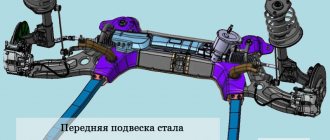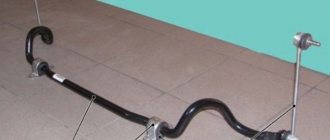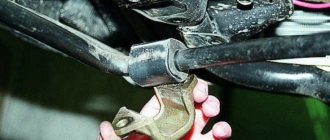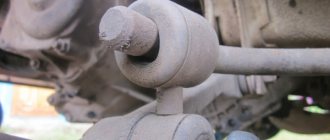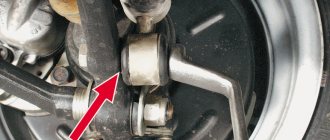How to get rid of creaking stabilizer bushings on Lada Vesta
There are two ways to eliminate the squeak:
- contacting a service station if the car is under factory warranty;
- Do-it-yourself repairs, regardless of whether there is a warranty.
Both methods do not guarantee the disappearance of the annoying sound. The reason lies in the material from which the bushing is made.
In most service stations with a defect using a metal-rubber aerosol. In the best case, they use a Litol type lubricant with the addition of a graphite base.
This “potion” lasts for several thousand miles, after which the sound returns.
The most effective and efficient way is to install non-standard seals from other car brands. It is advisable that the elastic bands are made of polyurethane.
In terms of dimensions and parameters, bushings from:
| Name/items | Price in rubles |
| Chevrolet Niva: articles 2123-2906046, 2123-2906040 | the average cost is from 160 – 170 rubles per piece. Polyurethane ones are 120 – 140 rubles more expensive than analogues |
| Kia Rio: part numbers: KSBSOULF 54813-2K100, 54814-1G000 | cost per set from 800 rubles |
*price indicated as of 03/06/2019.
What they tried to do
Since the squeaking situation bothered everyone who encountered it, AvtoVAZ took corrective measures to eliminate it. The first attempt to get rid of the squeak was to apply a film with heat shrinkage to the stabilizer bar in the area of the pillows. Then other pillows with a modified cut profile were supplied. But these actions did not give the desired effect, and the creaking appeared again.
The next step from the manufacturer was the supply of new stabilizer pads. They were made from a different material - polyurethane, not rubber. The color of the pillows was green. This technique turned out to be more effective than previous ones. But after a certain mileage, car owners again encountered creaking suspension.
In these cases, factory engineers ordered that the cushions be removed and a special silicone lubricant applied to them. But this did not lead to a final elimination of the problem, since the lubricant was washed out when water entered.
Many of those who wanted to solve this problem on their own installed stabilizer cushions from Chevrolet Niva, Kia Rio, Soul, Toyota. But in most cases, after some mileage, the hated creak appeared again. Many people wondered how to solve this problem?
The principle of operation of stabilizer bushings
The main purpose of the stabilizer, bushings, struts (bones) is to evenly distribute the load along the entire perimeter of the suspension.
The stabilizer is activated when the car enters turns to minimize roll. The bushing is compressed and unclenched in a metal bracket under the influence of pressure from the torsion rod.
Where the body “sags” on its side, the rack raises the frame, and lowers it on the opposite side. The greater the angle of inclination, the stronger the drag force of the suspension.
The main element of the suspension is a torsion bar with sealing bushings at the edges. It is fixed to the suspension, and its edges are connected to the levers.
Conclusion
Despite numerous tips and recommendations, replacing the stabilizer bushings with new ones made of polyurethane remains an effective way. Preferably from a Kia Rio or Chevrolet Niva.
In the first case, additionally buy “native” Korean metal brackets, since the Lada Vesta brackets are not compatible along the external contour. How effective and efficient it is to buy non-original components is up to you to decide, but the quality of the latter has been approved by more than one thousand car enthusiasts.
Briefly about the purpose and operating principle of the SPU
The VAZ team partially borrowed the design solution for the front suspension from their colleagues from Renault. In order for the replacement of stabilizer bushings on a Lada Vesta to be carried out purposefully and effectively, the cause of the breakdown must be correctly determined. For this, knowledge about the role of the SPU unit, as well as signs indicating the need for its repair, will not hurt.
A maneuver performed at speed definitely causes a side roll of the body, which can cause the car to roll over. It is to eliminate such consequences that a torsion-type anti-roll bar (STS) has been introduced into the front suspension. On Vesta, the part is installed only on the front axle of the car; its design features include the following facts:
- The main element is made of spring steel grades in the form of a round rod of a certain configuration.
- The rod is attached to the subframe using steel clamps and rubber bushings.
- Along the edges, the rod is attached to the front suspension struts using levers.
Principle of operation
Knowledge of the operating principles of this unit will help you understand the need to replace stabilizer bushings on a Lada Vesta car. They are based on the uniform redistribution of loads between the suspension elements. During lateral rolls, the stabilizer rods move in different directions. As a result, one end of the rod rises and the other goes down.
Rubber cushions that fix the middle part of the SPU allow it to twist around its axis with increasing body roll, due to which the position of the car on the track is adjusted. When making turns, the stabilizer struts additionally provide a high level of tire adhesion to the road surface.
Reviews
| № | Positive |
| 1. | Vasily , 34 years old (drive2.ru) Sverdlovsk: for the first time the seals creaked at 20,000 km, I went to the service station under warranty, the guys lubricated it with a metal-rubber aerosol. A year has passed - silence. |
| 2. | Petrovich , 44 years old (prom.ua), Krasnodar: the car is in its third year, no complaints, the suspension is working as normal. I've heard drivers complain about the crunching noise, but I didn't have that problem. |
| 3. | Alexander , 35 years old (autotoday.com), Omsk: I’m happy with the purchase of the Lada Vesta, I regularly visit the service station, I drive carefully, the speed limit is medium. |
| 4. | Ivanovich , 45 years old (rozetka.ua), Rostov-on-Don: my positive review of the Lada Vesta car in general. Good build quality, relatively cheap spare parts, developed network of car services. |
| 5. | Vyacheslavovich , 43 years old, Kursk (avtoflit.com): my first car was a Lada Priora, after which I bought a Vesta. The difference is noticeable in quality, assembly, and service life. Undoubtedly Lada Vesta is better. |
| 6. | Valery , 33 years old, Voronezh (autotoday.com): in three years of using the car, I visited a service station once to replace stabilizer bushings, not counting scheduled technical inspections. |
| 7. | Vasilievich , 46 years old, Ufa (drive2.ru): I take care of the equipment, periodically go to the inspection pit, check the fastenings and components. Over the course of three years, I lubricated the stabilizer bushings several times. I didn't do any more work on the suspension. |
| 8. | Semenych , 38 years old, Bashkortostan (drive2.ru): The Lada Vesta is well assembled, I’m pleased with the quality. I fix minor damage myself. Even when operating on rough terrain, the suspension absorbs bumps perfectly. |
| Negative | |
| 9. | Dmitrievich , 49 years old (prom.ua), Saratov: Vesta disappointed me, after 30,000 km the stabilizer seals creaked. I visited a service station, the guys lubricated it with an aerosol, and after 5000 km the situation with the “sound” repeated itself again. |
| 10. | Alexey , 46 years old, Moscow (avtoflit.com): in two years of using the car, I went to the workshop three times for suspension maintenance. Constant squeaks and crunches. The quality is raw, the machine has shortcomings that the manufacturer must eliminate. |
| 11. | Filippovich , 39 years old, Voronezh (drive2.ru): my opinion is that the Lada Priora was made with better quality than the Vesta. I bought it a year ago and now I regret it. There are a lot of shortcomings, defects, and expensive spare parts. |
| 12. | Valentin , 37 years old, Pskov (autotoday.com): if you are choosing a car between Lada Vesta and Renault Logan, then consider buying a French brand. |
Video - Stabilizer bushings solution to the problem
The first signal that a Lada Vesta requires replacement of the stabilizer bushings may be: extraneous sounds or creaks in the area of the front suspension when driving on uneven roads, poor handling at speeds over 60 km/h. Even if these symptoms are not significantly expressed, it is worth visiting a service station as soon as possible, or purchasing everything you need and repairing the car yourself.
Stabilizers consist of a rod, a clamp, a bushing, a stand and fasteners. It is important that the unit is always operational, otherwise the car may become unstable in turns, lose traction and tip over. One of the important elements of the unit is the bushing, which allows the rod to twist under load.
Contacting the dealer and AvtoVAZ’s position
If you have decided to contact a Lada dealership, you will most likely be unpleasantly surprised. The fact is that the Russian automaker, although it recognized the problem, took the simplest path to solving the issue.
At the dealership, the bushings are lubricated with grease.
The craftsmen do not replace the bushings, but simply lubricate them with PMS 400 grease. To carry out lubrication work, the unit is disassembled and then reassembled. PMS 400 is an emulsion-based lubricant with adhesive properties. It is widely used in defoamers and in plastic-to-metal contact areas. It has hydraulic, shock-absorbing, cooling and damping properties.
Required Tools
To work you need to prepare the following tools:
- head 10;
- spanner 16;
- hex open-end wrench 16;
- spanner 13;
- two jacks, if there is no inspection hole or overpass;
- Silicone Grease;
- rags.
Replacing the Lada Vesta stabilizer bushings with your own hands is quite advisable, since work in a car service center will cost at least 450 rubles as of 05/31/2019. In addition, you will save personal time and independently audit adjacent components and systems. Faulty bushings are indicated by:
- extraneous noise in the front suspension;
- deterioration in vehicle controllability at speeds of 60 km/h or more;
- the appearance of squeaking when driving through puddles or on roads with uneven surfaces.
The cause of squeaks in the LADA Vesta SW Cross was discussed online: “AvtoVAZ factory parasites”
Vesta creaks are already such a common occurrence for many users that they cause not so much concern as laughter.
One of the lucky owners of the LADA Vesta SW Cross was disturbed by the squeaks that appeared in the front panel opposite the passenger seat, which he shared in the VKontakte community dedicated to Vesta. The owner reported that the creaking is more like a rustling sound, and resembles either the sound when 220V wires are shorted, or the sound as if some animal is gnawing on something.
The author also added that before the creaking first appeared, the LADA Vesta had been left unstarted for more than six hours, and when the author got into the car and, without starting the engine, began to switch the heater positions, he immediately heard a noise.
Netizens discussed the reason for the appearance of squeaks in the LADA Vesta SW Cross below in the comments. One of the subscribers said that the author’s clarification about the muffled engine may indicate that there is a problem with the throttle valve. Another objected that he heard similar sounds in the running Vesta, as well as during the operation of the climate control.
One of the commentators did not find anything useful to say about the problem discovered by the author, so he began to joke: “Factory parasites of AvtoVAZ,” this is how he described the source of the rustling noise, adding that they have been appearing on Vestas since . Another joined and called Vesta a new name - “Lada Parasite”.
The next participant in the discussion, either jokingly or seriously, stated that mice could get into the LADA Vesta if there was no mesh on the air intake. And another commentator was sure that something got into the Vesta fan, which is why a strange creaking sound appeared - and if you let it work at maximum, the “interference” will soon “fly out”.
The design of the new suspension, which is included in the design of the Lada Vesta, is strikingly different from previous generations. The front chassis has become more complex and soft. This does not mean that a speed bump can be passed at high speed - driving at normal speed will be smoother, because the mechanism “absorbs” some of the vibrations. Read the article to the end and find out why knocking occurs in the front suspension
The chassis is the link between the wheels and the body. The wheels take all the impacts - from speed bumps, holes, potholes, curbs, and other irregularities that are on the way. The task of the mechanism is to soften the blow, reduce the rolling amplitude, while maintaining the integrity and functionality of the internal traces and assemblies - if they hit each other, this will lead to their unsuitability.
The more advanced representatives of the family's model range also distinguished themselves - the rear suspension of the Lada Vesta SV Cross is stronger than that of the standard version, it can withstand heavier loads, which allows it to carry more luggage.
Front suspension device
The design of the unit has changed noticeably. Even before repairing new Vests, technical centers had to be trained on the new model. The front suspension sits on a subframe, which was not seen on earlier VAZ models. As a result, the upper part above it (engine compartment, steering rack, etc.) received protection, and the lower part of the suspension received static fasteners. The steering rack, which is located above the subframe, is still located slightly lower than it was on previous models. This means that the steering linkage now works directly with the steering knuckle.
The steering shaft is supplemented with an electric power steering, which transmits the turning forces of the steering wheel to the wheels. The rack transmits force to the rods, and they work with the hubs - they allow you to control the movement of the wheels under control. The hub is also pressed against the disc brake, controlling the uniformity of its contact with the wheel.
The suspension itself is independent; on the Lada Vesta, the front mechanism levers are L-shaped. The right and left front suspension arms operate independently of each other. The transverse stabilizer has undergone modifications, which gave the car greater maneuverability, as well as better cornering control. Its struts are more like a sports car, they smooth out the effect of such maneuvers at speed.
Self-diagnosis of problems
If you don't like the way your vehicle drives over obstacles after a while, or turns into turns less smoothly. First, carry out diagnostics to eliminate other “suspects” and come to the technical center with a clear task for specialists:
The design of the front suspension of a front-wheel drive vehicle assumes that all its parts should “age” evenly, almost equally, that is, even if they have different wear patterns, they need to be replaced with new ones in pairs. New components will work evenly, “erasing” from scratch.
The rear suspension of the Lada Vesta consists of the following parts
- beam with silent blocks;
- barrel springs;
- spring insulating gaskets;
- double-acting gas-filled shock absorbers;
- shock absorber mounting bushings;
- levers.
Photo rear beam
Detected malfunctions in the suspension
Even during the release of the first batches of Vesta from the assembly line, buyers rightly noticed shortcomings in its work, which were corrected in subsequent batches. The sounds that the rear or front suspension can make are very varied - the design is very complex, consisting of many parts that can fail. However, the most common breakdowns among Lada Vesta owners stand out and are worth disassembling.
Creaking, crunching, knocking from the rear suspension of the Lada Vesta
Rear crunching is a fairly old problem for West. The knock of the rear chassis is corrected according to a special instruction from AvtoVAZ, according to which the design will have to be slightly supplemented. Between the upper support and the rear shock absorber strut you need to place a washer with a length of 130 mm, a distance between the holes of 100 mm (hole radii - 5 mm), a base radius of 34 mm, and finally a radius of the main hole of 25 mm.
The crunch will disappear, but only if the washer matches the dimensions, otherwise a gap will appear between the body and the support, into which dirt gets trapped. The cause of concern due to crunching or knocking may also be:
- worn trunk lid damper;
- stretched handbrake cable (it can be pulled from the passenger compartment);
- trunk lock;
- rear sofa backrest fasteners.
And just in case, check the contents of the trunk itself - there may just be tools rattling around there.
Bumping knocks and noises in the front suspension of Lada Vesta
The modernization of the Lada Vesta SV Cross received rear springs increased by 9 mm. Vesta SV Cross, in addition to springs, received redesigned shock absorbers and a retuned chassis, and its track became 14 mm wider than the standard one. Despite the improvements, knocking in the front suspension of the car also occurs.
The suspension of the Lada Vesta Sport deserves close attention. The diameter of the front shock absorber rod, working cylinder and strut housing was increased. Production was carried out not by SAAZ, but by Demfi, and the rear suspension also increased in size. Changes affected the rod, working cylinder and housing. The hub is now mounted with five bolts, and larger cast steel steering knuckles provide crisp, precise wheel turning.
Order of Operations
Important! You can begin repairs if the stabilizer bar is not tense. To do this, the front wheels need to be suspended or the weight of the car is evenly distributed - on a viewing hole or overpass. The place where the work will be performed must be washed.
So, the car is lifted with two jacks or driven into a pit, now you can start working:
- Clean the stabilizer bar fasteners from dirt.
- Completely unscrew the stabilizer link fixing nut and move it to the side. The same procedure must be performed on the other side of the machine.
- There is a cover on the steering system casing that protects it from contamination. It needs to be removed. To do this, five bolts are removed.
Now you can unscrew the two bolts securing the brackets.
The bracket or clamp is removed from its place.
Now you can remove the bushing.
- The rod must be thoroughly wiped, and particles from the old bushing must be removed, especially at the fastening points. The operation is repeated for the second element.
- The rod needs to be rubbed with lubricant so that the new parts can easily fit on it and move easily.
- A new element is installed on the rack.
- The same procedure will be repeated with the second bushing.
- Next you need to do the assembly. It is performed in reverse order.
The bushing moves along the rod to the installation site.
On site, you need to accurately align the bushing along the axis of rotation and fit.
You can also watch the procedure for replacing stabilizer bushings on a Lada Vesta in this video:
Killing squeaks/knocks in the interior
Well, as I said before, I didn’t publish blog entries because of my laziness



